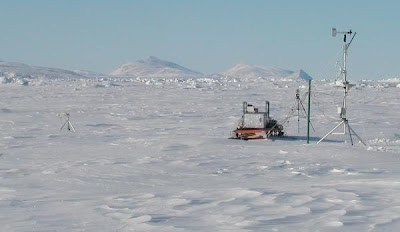
En el Ártico y durante la primavera, se liberan óxidos de nitrógeno desde la nieve. Este fenómeno, cuya importancia había pasado desapercibida, es el origen de la tercera parte de los nitratos existentes en la atmósfera del Ártico.
Los nitratos se originan en latitudes medias, no solo por fenómenos naturales, como rayos e incendios forestales, sino también debido a la actividad humana. Los óxidos de nitrógeno se oxidan rápidamente a nitrates que, incorporados a la matería sólida suspendida, son transportados por las corrientes de aire. En el Ártico, y durante otoño, invierno y primavera, el nitrato se deposita sobre la nieve. Cuando la nieve se expone a la radiación solar durante el verano, el nitaro se vuelve a transformar en óxidos de nitrógeno que emitidos a la atmósfera, originan perturbaciones de la química atmosférica ártica.
La extensión de este fenómeno debe cuantificarse, pero los ionvestigadores han encontrado interacciones químicas fuertes entre los óxidos de nitrógeno liberados desde la capa de nieve, y los compuestos halogenados (en particular loas radicales BrO) implicados en la destrucción del ozono, en los niveles bajos de la atmósfera durante la primavera ártica.
In the Arctic in spring, the snow cover gives off nitrogen oxides. This phenomenon, the extent of which had not been previously realized, is the source of one third of the nitrates present in the Arctic atmosphere.
At temperate latitudes nitrogen oxides are produced not only by natural phenomena such as lightning and forest fires, but also by human activity, such as combustion in engines and industrial activity. Nitrogen oxides are rapidly oxidized to nitrate, which, incorporated into atmospheric particulate matter, is transported by air currents. In the Arctic, in autumn, winter and spring, the nitrate is deposited onto the snow cover. Then, when the snow is exposed to solar radiation, the nitrate turns into nitrogen oxides that are emitted to the atmosphere, causing disturbances in Arctic atmospheric chemistry.
The extent of this phenomenon remained to be quantified, but the researchers have found strong chemical interactions between the nitrogen oxides emitted by the snow cover and the halogenated compounds (in particular BrO radicals) that are involved in the phenomena of ozone destruction in the lower levels of the atmosphere in Artic spring.
Tomado de/Taken from Science Daily
Resumen de la publicación/Abstract of the paper Tracing the Origin and Fate of NOx in the Arctic Atmosphere Using Stable Isotopes in Nitrate
No hay comentarios:
Publicar un comentario